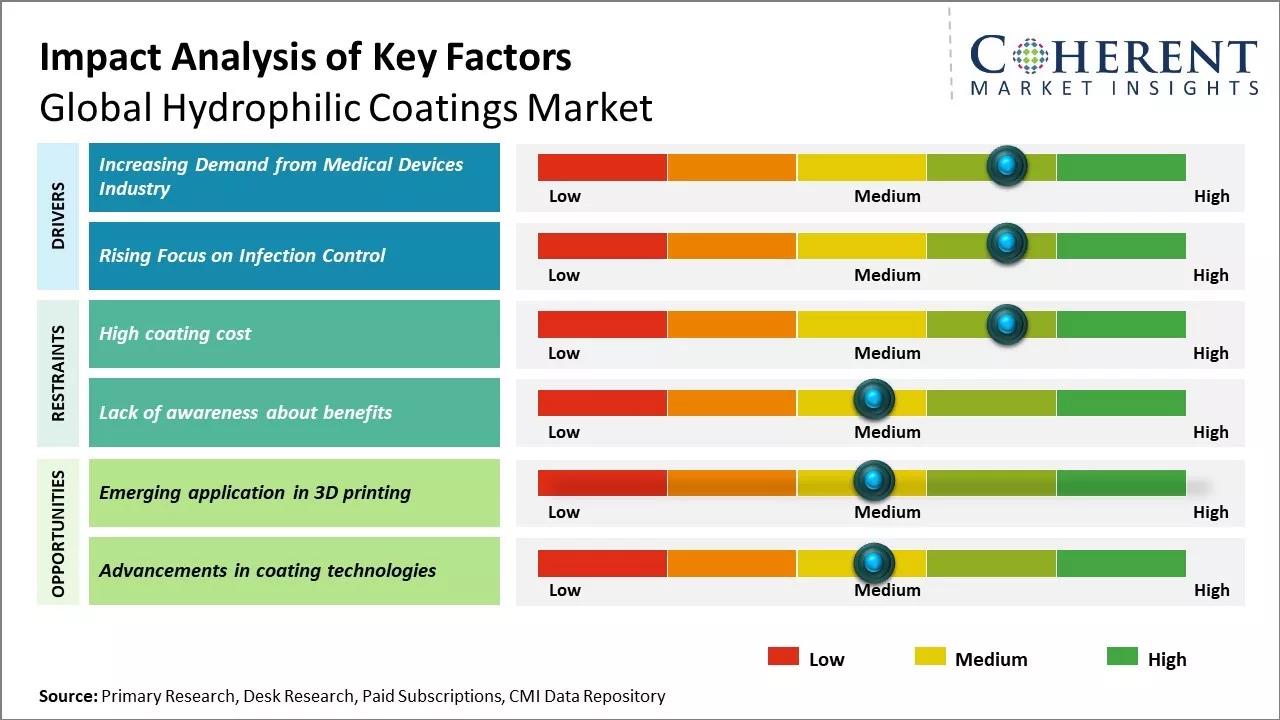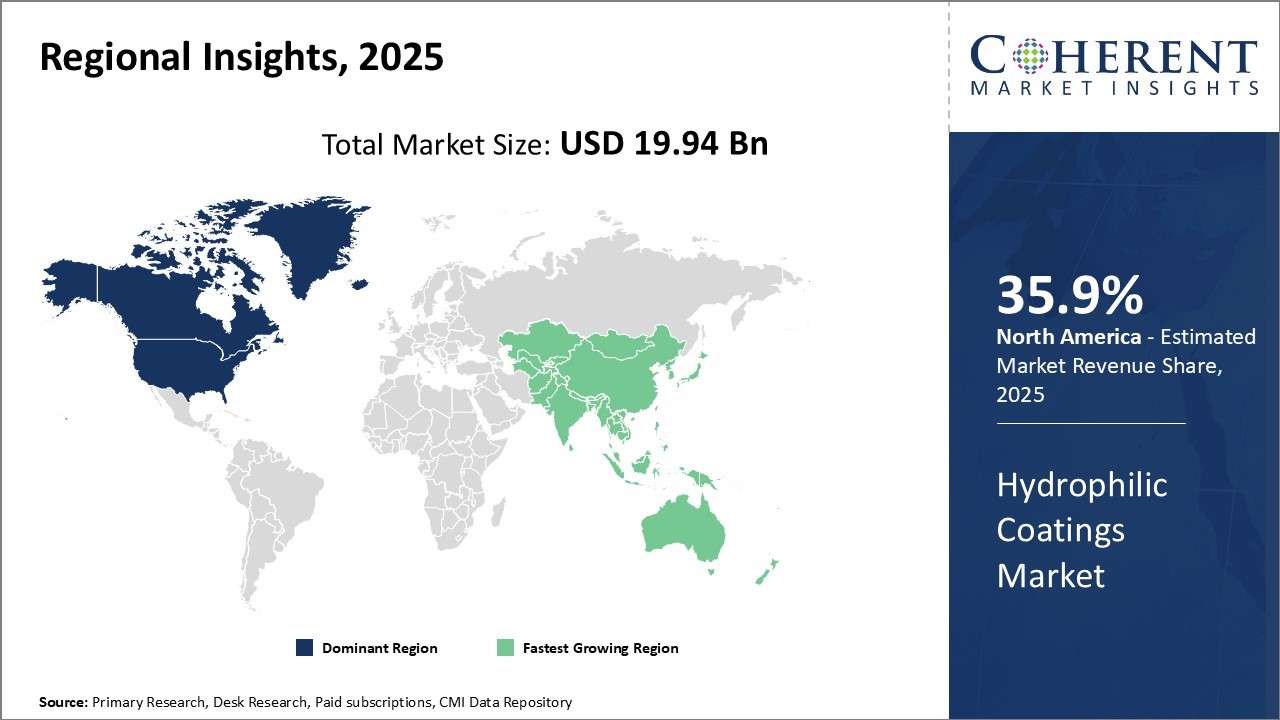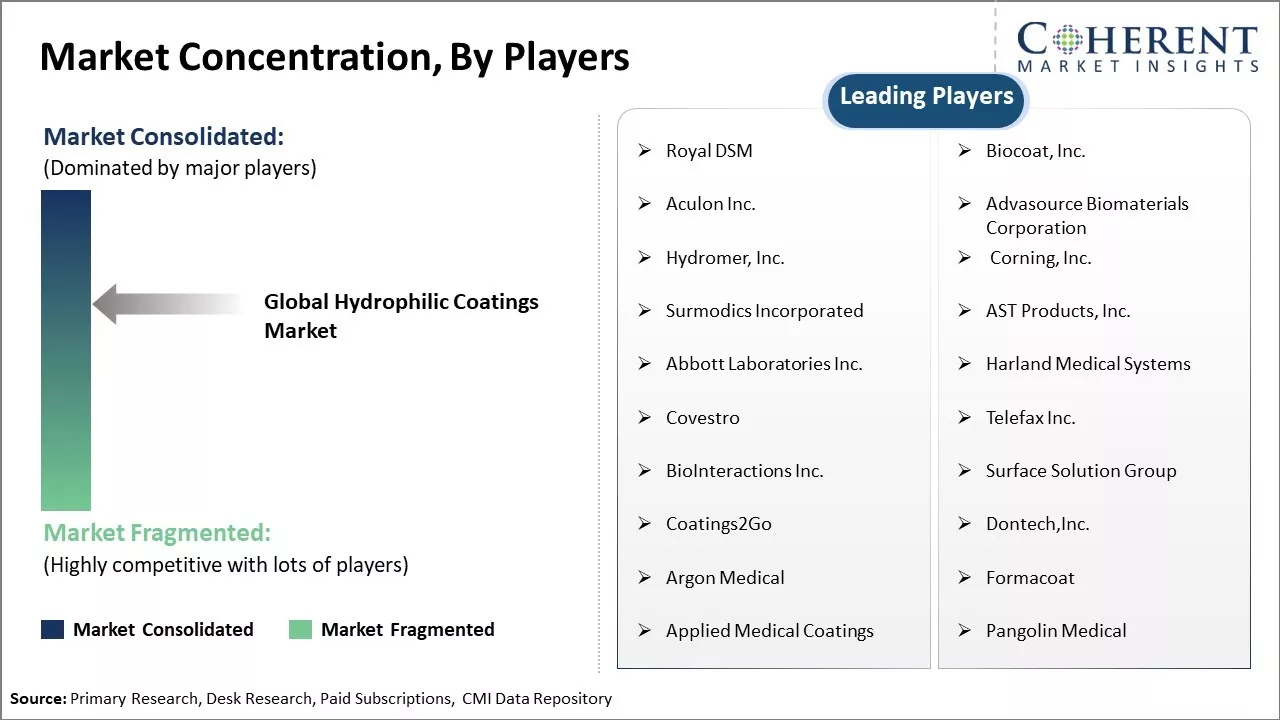The global hydrophilic coatings market is estimated to be valued at USD 19.94 Bn in 2025 and is expected to reach USD 30.00 Bn by 2032, exhibiting a compound annual growth rate (CAGR) of 6% from 2025 to 2032.

To learn more about this report, Download Free Sample
The hydrophilic coatings market is expected to witness significant growth over the forecast period. The increasing application of hydrophilic coatings in the medical device industry is driving the market growth. Hydrophilic coatings are widely used to coat catheters, guidewires, balloons, and stents as they provide surface properties like biocompatibility and lubricity. There is a growing demand for minimally invasive surgeries which is further propelling the demand for coated medical devices. The rising prevalence of chronic diseases and the growing geriatric population are also contributing to the growth of the hydrophilic coatings market.
In March 2024, Hydromer Inc. relaunched its legendary SeaSlide™ hydrophilic watercraft coating as Super SeaSlide™. The new and improved formulation is expected to offer enhanced performance and durability for watercraft applications.
|
Current Events |
Description and its impact |
|
Boom in Medical Device Coatings Improves Patient Safety and Comfort
|
|
|
Growth of Hydrophilic Coatings for Medical Device Use
|
|
Uncover macros and micros vetted on 75+ parameters: Get instant access to report
Emerging technologies are playing a revolutionary role in the field of hydrophilic coatings, enhancing product performance, sustainability, and application efficiency. Among them is nanotechnology-based coating development, which enables higher lubricity, uniformity, and microscopic adhesion increase, most beneficial for complex medical devices like catheters and stents. Thermal cure technologies such as recently patented ones by Biocoat Inc. are gaining more interest for enabling high-performance coatings that are stronger and PFAS-free.
Smart coatings that respond to external stimuli like pH, temperature, or humidity are also being researched, especially for biomedical uses in drug delivery or infection prevention. Plasma-enhanced chemical vapor deposition (PECVD) and UV-curable coatings are also emerging as effective, eco-friendly replacement technologies for solvent-based technologies, with lower environmental footprint and higher throughput.
Digitalization and AI-driven quality control systems are increasing precision in coating application, removing defects and delivering consistent product quality. Digitalization and these technologies do not only maximize performance but also reduce production costs in the longer term. As a result of the increasing demand for minimally invasive procedures and green healthcare products, these technologies will definitely reshape the future of the hydrophilic coatings market in a gigantic way.
Polymers are expected to account for 30.3% share of the global hydrophilic coatings market in terms of substrate in 2025. This can be attributed to the various advantages polymers offer over other substrates such as glass/ceramics and nanoparticles. Polymers are highly durable, flexible, and can be easily molded into different shapes and sizes as per the end-use requirement. Their lightweight nature and high strength to weight ratio makes them suitable for applications where weight is a critical factor such as in medical devices and automotive.
Polymers offer excellent corrosion resistance which is a key property required for hydrophilic coatings used in medical devices that come in contact with body fluids and tissues. Polymers are also economical compared to other substrates, enabling hydrophilic polymer coatings to be cost effective for high volume applications.
Advancements in polymer engineering have led to the development of novel polymers that exhibit enhanced hydrophilicity, biocompatibility, and mechanical properties. This has further increased polymer usage as preferred substrates for hydrophilic coatings in growing end-use industries. The ease of applicability and processing of polymer substrates also contributes to their higher market share. Overall, the versatile properties of polymers make them strongly suitable as substrate for hydrophilic coatings.
The global hydrophilic coatings market witnesses the highest demand from medical devices application with 42.6% share in 2025. Hydrophilic coatings play a vital role in medical devices by providing surface properties like biocompatibility and corrosion resistance.
The growing prevalence of chronic diseases and conditions along with rising aging population has increased the need for advanced medical treatments. This is accelerating the demand for various medical devices such as catheters, guidewires, implant components, and diagnostic equipment which require hydrophilic coatings.
Catheters particularly demand hydrophilic coatings for lubricious and non-thrombogenic properties. Rising number of surgical procedures relying on catheter-based techniques is a major factor augmenting their consumption. Hydrophilic coatings are highly essential to impart required functionalities in implant components as well.
Furthermore, increasing healthcare expenditures especially in developing nations have boosted the affordability of medical treatments. This favors the market growth as wider access to healthcare expands the demand for assisted medical devices. Strong focus on product innovation is also presenting opportunities in the medical devices segment.

To learn more about this report, Download Free Sample
North America has been dominating the global hydrophilic coatings market. The region is expected to account for 35.9% share in 2025, and is expected to retain its leading position in the coming years. The presence of a well-established medical device industry and high healthcare spending in the U.S. and Canada have boosted the demand for hydrophilic coatings in this region.
Major medical device manufacturers are based in North America, who are the key consumers of hydrophilic coatings used in devices such as urinary catheters, guidewires, balloon catheters, and stents. Moreover, strict regulations regarding product safety and performance approval in the healthcare sector encourage the use of advanced hydrophilic coatings
Asia Pacific has emerged as the fastest growing market for hydrophilic coatings globally. Rapidly developing healthcare infrastructure, growing medical tourism, and rising healthcare expenditures are driving the market growth. With improving economy and increasing disposable income, more people can afford expensive medical treatments. This is translating to higher sales of medical devices.
Another factor is the presence of major generic drug manufacturers in Asia Pacific who export cost-effective devices to other markets. Countries like India, China, Japan, and South Korea are seeing substantial rise in the production and export of medical devices. This widespread production base of devices is propelling the demand for hydrophilic coatings from APAC.
The U.S. holds the position of the topmost player in the hydrophilic coatings market because the country has sophisticated healthcare infrastructure and robust medical device manufacturing capacity. Demand for minimally invasive surgery devices and continuous R&D outlay by companies such as Surmodics and Biocoat are fueling growth and usage in the country.
Japan's market leadership in the hydrophilic coatings industry is due to its age population and high rates of chronic diseases, reflecting on the increased need for coated medical devices. The Japanese institutions have the most advanced nanotechnology and precision coating technology, providing the best quality output both domestically and for export.
China has quickly evolved into a force to be reckoned with as a result of its booming health industry and increasing investment in the manufacture of medical devices. Government policy towards expanding domestic manufacturing, R&D and increasing volumes for surgery is driving demand in China for hydrophilic coatings.
India is also witnessing fast development of the hydrophilic coating market in terms of better access to healthcare, medical tourism, and need for affordable medical devices. Local manufacturers are raising production and adopting global coating technology as a drive to achieve local as well as foreign markets.
| Report Coverage | Details | ||
|---|---|---|---|
| Base Year: | 2024 | Market Size in 2025: | USD 19.94 Bn |
| Historical Data for: | 2020 To 2024 | Forecast Period: | 2025 To 2032 |
| Forecast Period 2025 to 2032 CAGR: | 6% | 2032 Value Projection: | USD 30.00 Bn |
| Geographies covered: |
|
||
| Segments covered: |
|
||
| Companies covered: |
Royal DSM, Biocoat, Inc., Aculon Inc., Advasource Biomaterials Corporation, Hydromer, Inc., Corning, Inc., Surmodics Incorporated, AST Products, Inc., Abbott Laboratories Inc., Harland Medical Systems, Covestro, Telefax Inc., BioInteractions Inc., Surface Solution Group, Coatings2Go, Dontech,Inc., Argon Medical, Formacoat, Applied Medical Coatings, and Pangolin Medical |
||
| Growth Drivers: |
|
||
| Restraints & Challenges: |
|
||
Uncover macros and micros vetted on 75+ parameters: Get instant access to report
The global hydrophilic coatings market is witnessing significant growth in demand from the medical devices industry. There is a growing need for indwelling medical devices such as catheters, guidewires, blood gas analyzers, and endotracheal tubes which require hydrophilic coatings for improved performance. These coatings help in reducing friction during the insertion and removal of medical devices and also prevent thrombus formation.
Several types of catheters such as urinary catheters, central venous catheters, and cardiovascular catheters are designed to remain indwelling inside the body for longer periods. Hydrophilic coatings enhance comfort for patients as these coatings get activated with bodily fluids and lubricate the surface of catheters. This reduces any discomfort caused during the insertion and removal of catheters.
The growing prevalence of various cardiovascular, urological, and neurological conditions is boosting the number of diagnosis and treatment procedures carried out which involves the use of indwelling medical devices. Additionally, rising focus on minimally invasive surgeries is further driving the demand for advanced catheters and guidewires.
Another key driver for the hydrophilic coatings market is the increasing focus on infection control across various end-use industries. Hydrophilic coatings are widely used on catheters, implants, valves, and other medical devices to prevent microorganism adhesion and subsequent device related infections. These coatings activate in aqueous environments and create an impervious coating on the surface which discourages microbial attachment and biofilm formation.
With growing importance given to hospital acquired or device related infections, hydrophilic coatings are being more commonly used by medical device manufacturers and hospitals. Strict regulations regarding hygiene and infection control in hospitals have further raised the importance of such anti-microbial coatings. Even in other industries including food processing and pharmaceuticals, hydrophilic coatings are gaining acceptance as they help in improving hygiene and safety.
In the United States, the Federal Trade Commission (FTC) intervened in March 2025 to block a merger between Surmodics and Biocoat, citing concerns that the combined entity would control over 50% of the hydrophilic coatings market, potentially leading to higher healthcare costs. This move underscores the competitive dynamics and the critical role of innovation in maintaining affordable healthcare solutions.
The development of 3D printing technology has unveiled new uses for hydrophilic coatings. Conventional 3D printing techniques yield parts with hydrophobic, rough surfaces that are likely to be contaminated and corroded. With the inclusion of hydrophilic polymers in printable composite materials, smooth hygienic coatings on 3D printed objects can now be achieved. This is very promising in medical and healthcare applications.
Hydrophilic coatings enable 3D printed implant components, prosthetics and surgical guides to be seamlessly integrated within the body. They reduce the risks of infection and rejection. The application of hydrophilic coatings to 3D printed medical devices through customizable composite filaments is projected to grow substantially in the coming years according to recent reports from the United Nations.

To learn more about this report, Download Free Sample
*Definition: The global hydrophilic coatings market involves the production and sale of hydrophilic coatings that are applied to various surfaces and materials. These types of coatings contain hydrophilic functional groups that allow the coated surfaces to interact with water via surface hydration. They are used across many industries like medical devices, optics, aerospace, and automotive due to their ability to reduce drag and resist soiling on surfaces.
Share
Share
About Author
Yash Doshi is a Senior Management Consultant. He has 12+ years of experience in conducting research and handling consulting projects across verticals in APAC, EMEA, and the Americas.
He brings strong acumen in helping chemical companies navigate complex challenges and identify growth opportunities. He has deep expertise across the chemicals value chain, including commodity, specialty and fine chemicals, plastics and polymers, and petrochemicals. Yash is a sought-after speaker at industry conferences and contributes to various publications on topics related commodity, specialty and fine chemicals, plastics and polymers, and petrochemicals.
Missing comfort of reading report in your local language? Find your preferred language :
Transform your Strategy with Exclusive Trending Reports :
Frequently Asked Questions
Joining thousands of companies around the world committed to making the Excellent Business Solutions.
View All Our Clients